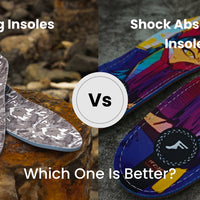The Cultural Impact Of Footwear: How Insoles Shape Traditions Around The World

The world of footwear is rich with cultural traditions, and insoles play a pivotal role in many of them. From moccasins in North America to geta in Japan, insoles have been used for centuries to shape the fit and comfort of traditional footwear. One of the most intriguing aspects of traditional insoles is the use of natural materials like cork and leather, which are shaped to conform to the unique contours of each individual's feet. This level of customization is what makes traditional insoles so special, and it's a tradition that's still alive and well in many parts of the world today. Let's explore the fascinating world of traditional insoles and the cultures that have embraced them!
Cultural Impact Of Footwear: The Asian Ascendancy
In a lot of Asian countries, insoles have transcended their utilitarian purpose to become symbols of status and tradition. The Japanese perfected the art of making insoles from layers of fabric and rice straw, creating a lightweight and comfortable insole that was worn with sandals and geta (traditional wooden clogs). In China, insoles made from thick layers of cotton were used in traditional boots and slippers, providing warmth and cushioning for the feet. India's contribution to modern insoles is the use of natural materials like jute and coconut husk to create a breathable and eco-friendly insole.
These traditions paved the way for the modern insoles we know today - built with materials like EVA foam and gel, and designed to provide support and comfort in any shoe.
Cultural Impact Of Footwear: The African Adroitness
Africa has a rich history of traditional footwear, including sandals, moccasins, and thonged shoes, which often had insoles made from natural materials like grass, reeds, and animal skins. In recent years, African designers have been blending traditional techniques with modern technology to create unique and sustainable orthotic insoles that are tailored to the unique needs of African feet. These insoles are often made from materials like jute, coconut husk, and rubber, and are designed to provide support, comfort, and shock absorption.
By using natural and sustainable materials, African designers are creating orthotic insoles that are not only good for the environment but also good for the people who wear them!
Cultural Impact Of Footwear: The European Elegance
European insoles have a long and fascinating history, beginning in ancient Greece and Rome with the use of sandals with insoles made of woven straw or animal skins. In the Middle Ages, leather and wood insoles were used in shoes to provide support and cushioning. By the 18th century, the Industrial Revolution brought new materials and techniques to Europe, and cork insoles became popular for their durability and shock absorption. In the 20th century, European insoles saw the introduction of modern materials like foam, gel, and EVA (ethylene vinyl acetate), which are still widely used in modern insoles.
European insoles have evolved over time, but their primary purpose remains the same: to provide comfort and support for the feet.
Conclusion
While traditional insoles have a long and storied history, FP Insoles represent the cutting edge of modern foot comfort. Like their predecessors, FP Insoles are designed to provide support and comfort for the feet, but with advanced technology and materials, plus strategically placed padding. With a focus on performance and durability,FP Insoles offer a level of support and cushioning that traditional insoles simply can't match. In short, while traditional insoles are steeped in tradition, FP Insoles are focused on innovation, giving your feet the comfort and support they need to perform at their best.





